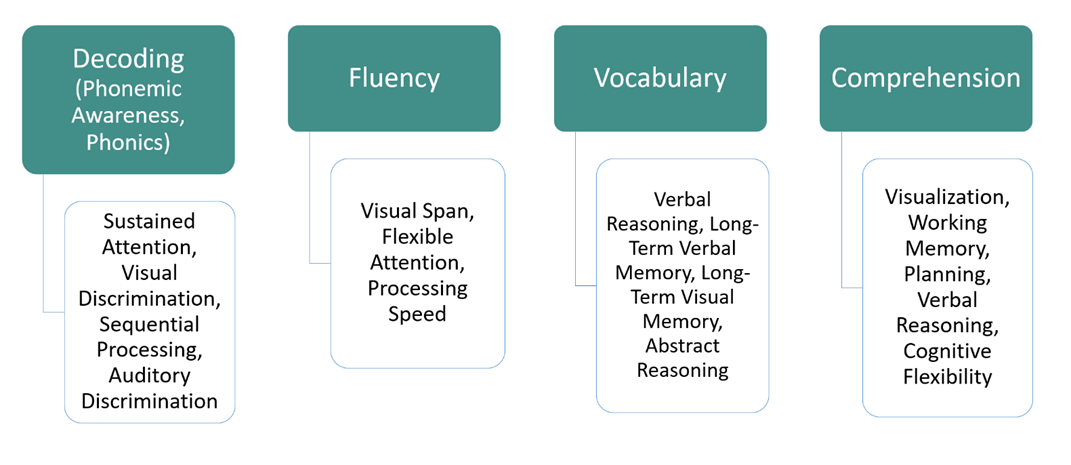Education is moving from being based on folklore to being grounded in science at an ever-faster pace. The sciences that are playing a greater role encompass both “traditional” education research as well as research findings from neuroscience, cognitive science, psychology and other related fields. Recently there has been an explosion of attention to the science of reading.
There is, in fact, science that explains reading. We know quite a lot today about how reading happens in the brain and the push is to use that information to improve reading instruction. The new, scientifically supported view identifies five components of reading:
- Phonemic Awareness
- Phonics
- Fluency
- Vocabulary
- Comprehension
While that may not sound much different from previous lists of reading “basics,” the emphasis has firmly shifted to phonemic awareness (being able to hear and identify the meaningful sounds of a language) and phonics (explicit instruction on the connection between symbols (letters and combinations of letters) and sounds)). This shift is consistent with extensive neuroscience research on the pathways in the brain that enable reading.
The science of reading reminds us that, while humans evolved for language, we did not evolve for reading. Therefore, each person – we might say, each brain – must learn to read on its own. Unlike learning to speak, which most of us do with exquisite ease, learning to read can be darn-right laborious. For most of us, it requires instruction, and the quality of that instruction can make a tremendous difference. The science of reading can be very helpful in guiding instruction to improve reading achievement. And as we know, there is plenty of room for improvement with only 35 percent of fourth graders reading proficiently at grade level, according to national statistics.
There is, in fact, no decoding part of the brain. In fact, in order to decode words – to associate a phoneme (language sound) with a symbol (visual representation, letters) – our brains need to create a pathway and communication between parts of our brains that are not otherwise connected in this way. Our brains evolved for spoken language, but not for reading, so we co-opt existing systems (an area towards the back of the brain called the Visual Word Form Area and the brain region responsible for spoken language, called Broca’s Area) to be able to read.
But the science of reading needs to be considered in the broader context of the science of learning. What the science of reading, at least in its initial form, does not explain is that there are mental processes that are even more basic than phonemic awareness, phonics, fluency, vocabulary and comprehension. These more basic processes are what enable our brains to take in, give meaning to (comprehend), organize, store, retrieve and apply information. These mental processes are called cognitive skills. The science of reading (as it is being discussed currently) does not, for example, address cognitive skills such as sustained attention, visual span, sequential processing, visualization, working memory, inhibitory control and cognitive flexibility, all of which are integral to reading.
The science of learning leads us to consider the impact on a student who has stronger or weaker cognitive skills in each of these areas.
Sustained attention: The ability to stay on task for sustained periods of time.
Relevance: Weaker sustained attention could mean that a student’s attention wanders off partway through decoding a word or a sentence or a paragraph, resulting in gaps in what their brains take in or requiring them to go back and start over.
Visual span: The ability to process a volume of visual information with a glance.
Relevance: Students who see a letter at a time or a word at a time will likely struggle to decode accurately and build fluency. Students who can take in groups of words or whole lines of text are more likely to get the gist of a text, as well as the meaning of specific words.
Sequential processing: The ability to see objects in a sequential order, as in reading.
Relevance: Objects may be letters, words, phrases or ideas. Some students’ brains don’t retain the order in which information was taken in. So, 5+7 may be seen as 7+5. Fortunately, addition is forgiving. But subtraction is not. The statement 5-7 means something very different than 7-5. And in reading, the order of letters is always important. Bad and dab are simply two very different words, although they contain the same letters and adb has no meaning at all.
Visualization: The ability to recall an image of what has been seen and to mentally manipulate or change aspects of that image in the mind.
Relevance: One strategy strong readers often use to comprehend and remember what they read is to create a mental image of it. A teacher might say, “Can you see that scene in your mind?” Some students do this very easily. For others, their “mind’s eye” has not developed to support this way of seeing and remembering. Lack of comprehension and lack of retention are likely for them.
Working memory: The ability to hold and manipulate information consciously in the mind.
Relevance: Working memory is what enables us to hold information in mind while we read from the beginning to the end of the sentence, to bear the relationships in mind, to compare what we are reading to what we already know to give it meaning, and to know whether or not we are understanding what we are reading. Research shows that working memory capacity and reading comprehension are highly correlated. Not only do we have to hold information in mind to understand it in the moment, holding and manipulating information in working memory is essential if the information is ever to be stored in long-term memory.
Inhibitory control: The ability to suppress a thought or idea and to refrain from doing something one otherwise would do.
Relevance: Students who “blurt out” words when they read are often thought to be guessing from context. Research suggests that the issue is more likely related to inhibitory control (or the lack thereof). The mental process of suppressing a word candidate (which is the same mental process as suppressing other ideas or actions), needs to be working well in skillful reading.
Cognitive flexibility: The ability to change our mindset when the rules of the world around us change, to shift between mental processes.
Relevance: The science of reading tells us that there are two different processes (pathways in the brain) that are used for sounding out words and recognizing sight words. The science of learning tells us that our brain’s ability to switch back and forth between these processes involves cognitive flexibility. Cognitive flexibility also is what allows us to understand different characters’ points of view or to revise our thinking when we realize that we had something wrong – for example, giving up on the idea that it had to be the butler when it turns out he had an ironclad alibi).
While phonemic awareness, phonics, vocabulary and comprehension are essential reading skills, they do not fully capture what is required for our brains to master reading, as shown in the figure below.

The science of reading as it is currently conceptualized is very important. It makes clear some important principles about how reading instruction needs to happen to be effective. But it doesn’t explain why, even with excellent instruction based on the science of reading and structured literacy, many students will struggle to perform reading tasks as expected. In other words, science-based reading instruction is necessary but not sufficient. We need the science of learning in order to address students’ capacity to acquire new skills and knowledge, including reading, math and everything else we expect them to be able to do.
The science of reading makes clear how essential the teacher is to most students’ ability to learn to read. In the recent frenzy to propagate the science of reading, teacher professional development is job one, training teachers in using the techniques of structured literacy. There are significant challenges to meeting the goal of broadly overhauling reading instruction, however. Not only are we in the midst of a crippling teacher shortage, but when trained teachers leave, all that knowledge leaves with them. Teachers and administrators also report that it can take two to three years for teachers to master these new approaches.
As those efforts unfold, we can attack the mission on another front, using the science of learning. The science of learning recognizes that the cognitive capacity of the learner — the strength of individual cognitive skills, including those discussed above, and the ability of those skills to work together in an integrated and efficient way — is another vital part of an equation that represents how strong readers develop. The science of learning informs us that cognitive capacity can be developed. Improving an individual’s cognitive capacity through the right kind of cognitive skills training, and thereby improving everything that individual does with their cognitive processes, whether reading, math, sports, work, or any other part of life, is something that perfectly complements any learning pathway.
Technology now enables comprehensive, integrated cognitive skills training to be delivered by teachers’ aides or even older students who have been through cognitive training programs (think of 6th graders working with 2nd and 3rd graders), as well as teachers.
Also, cognitive training programs are, generally speaking, a one-time investment, as opposed to an ongoing expense. For most students, the exposure will be a one-time intervention, for 12-14 weeks, rather than something that needs to be taught (and for which, multiple grades of teachers need to be trained) year after year. The current stimulus funding, because it will not be repeated, could be allocated to cognitive training in a strategic manner that can strengthen learning capacity for a broad range of students that they will carry with them into all their future learning experiences.
As educators living in a day when neuroscience is increasingly guiding our understanding of how learning happens in our students’ brains, let us embrace the science of reading and let us get busy extending that to the science of learning.
About the authors

Betsy Hill is President of BrainWare Learning Company, a company that builds learning capacity through the practical application of neuroscience. She is an experienced educator and has studied the connection between neuroscience and education with Dr. Patricia Wolfe (author of Brain Matters) and other experts. She is a former chair of the board of trustees at Chicago State University and teaches strategic thinking in the MBA program at Lake Forest Graduate School of Management where she received a Contribution to Learning Excellence Award. She received a Nepris Trailblazer Award for sharing her knowledge, skills and passion for the neuroscience of learning in classrooms around the country. She holds a Master of Arts in Teaching and an MBA from Northwestern University.

Roger Stark is Co-founder and CEO of the BrainWare Learning Company. Over the past decade, he championed efforts to bring comprehensive cognitive literacy skills training and cognitive assessment within reach of every person, and it all started with one very basic question: What do we know about the brain? From that initial question, Roger Stark pioneered the effort to build an effective and affordable cognitive literacy skills training tool, based on over 50 years of trial and error through clinical collaboration. He also led the team that developed BrainWare SAFARI, which has become the most researched comprehensive, integrated cognitive literacy training tool delivered online anywhere in the world. For more, follow BrainWare Learning on Twitter @BrainWareSafari











